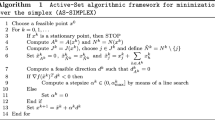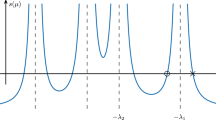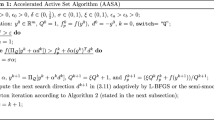Abstract
A new algorithm, the dual active set algorithm, is presented for solving a minimization problem with equality constraints and bounds on the variables. The algorithm identifies the active bound constraints by maximizing an unconstrained dual function in a finite number of iterations. Convergence of the method is established, and it is applied to convex quadratic programming. In its implementable form, the algorithm is combined with the proximal point method. A computational study of large-scale quadratic network problems compares the algorithm to a coordinate ascent method and to conjugate gradient methods for the dual problem. This study shows that combining the new algorithm with the nonlinear conjugate gradient method is particularly effective on difficult network problems from the literature.
Similar content being viewed by others
References
A.V. Aho, J.E. Hopcroft, and J.D. Ullman, The design and analysis of computer algorithms, Addison-Wesley: Reading, MA, 1974.
A. Bachem and B. Korte, “Minimum norm problems over transportation polytopes”, Linear Algebra and Its Applications 31 (1980), 103–118.
P. Beck, L. Lasdon, and M. Engquist, “A reduced gradient algorithm for nonlinear network problems”, ACM Trans. on Math. Software 9 (1983), 57–70.
D.P. Bertsekas and D. El Baz, “Distributed asynchronous relaxation methods for convex network flow problems”, SIAM J. on Control and Optimization 25 (1987), 74–85.
D.P. Bertsekas, P.A. Hosein, and P. Tseng, “Relaxation methods for network flow problems with convex arc costs”, SIAM J. on Control and Optimization 25 (1987) 1219–1243.
G.R. Bitran and A.C. Hax, “Disaggregation and resource allocation using convex knapsack problems with bounded variables”, Mgt. Sci. 27 (1981), 431–441.
F.H. Clarke, “Generalized gradients and applications”, Trans. of the American Mathematical Society 205 (1975), 247–262.
M. Collins, L. Copper, R. Helgason, J. Kennington, and L. LeBlanc, “Solving the pipe network analysis problem using optimization techniques”, Mgt. Sci. 24 (1978), 747–760.
L. Cooper and J. Kennington, “Steady state analysis of nonlinear resistive electrical networks using optimization techniques”, Tech. Report IEOR 77012, Southern Methodist University, Dallas, TX, 1977.
R.W. Cottle, S.G. Duvall, and K. Zikan, “A Lagrangean relaxation algorithm for the constrained matrix problem”, Nav. Res. Logistics Q. 33 (1986), 55–76.
L.H. Cox, “Solving statistical confidentiality problems via network optimization,” TIMS/ORSA Joint National Meeting, New Orleans, LA, 1987.
J.L. Debiesse and G. Matignon, “Comparison of different methods for the calculation of traffic matrices”, Annales des Telecommunications 35 (1980), 91–102.
R.S. Dembo and J.G. Klincewicz, “A scaled reduced gradient algorithm for network flow problems with convex separable costs”, Math. Programming Study 15 (1981), 124–147.
R.S. Dembo, “A primal truncated Newton algorithm with application to large-scale nonlinear network optimization”, Math. Programming Study 31 (1987), 43–72.
M.E. El-Hawary and G.S. Christensen, Optimal economic operation of electric power systems, Academic Press: New York, NY, 1979.
A. George and J.W.H. Liu, Computer Solution of Large Sparse Positive Definite Systems, Prentice-Hall: Englewood Cliffs, NJ, 1981.
C.R. Glassey, “A quadratic network optimization model for equilibrium of single commodity trade flows”, Math. Programming 14 (1978), 98–107.
Goldfarb and Idnani, “A numerically stable dual method for solving strictly convex quadratic programs”, Math. Programming 27 (1983), 1–33.
C.D. Ha, “A generalization of the proximal point algorithm”, SIAM J. on Control and Optimization 28 (1990), 503–512.
W.W. Hager, “Inequalities and approximation”, in Constructive Approaches to Mathematical Models, C.V. Coffman and G.J. Fix, eds., Academic Press: New York, NY, 1979 189–202.
W.W. Hager, “Dual techniques for constrained optimization”, J. of Optimization Theory and Applications 55 (1987), 37–71.
W.W. Hager, “A derivative-based bracketing scheme for univariate minimization and the conjugate gradient method”, Computers and Math. with Applications 18 (1989), 779–795.
W.W. Hager, “Updating the inverse of a matrix”, SIAM Review 31 (1989), 221–239.
W.W. Hager, “The dual active set algorithm”, in Advances in Optimization and Parallel Computing, P.M. Pardalos, ed., North Holland: Amsterdam, The Netherlands, 1992, 137–142.
W.W. Hager and G.D. Ianculescu, “Dual approximations in optimal control”, SIAM J. on Control and Optimization 22 (1984), 423–465.
D.W. Hearn, S. Lawphongpanich, and J.A. Ventura, “Restricted simplicial decomposition: Computation and extensions”, Math. Programming Study 31 (1987), 99–118.
R.V. Helgason, J. L. Kennington, and H. Lall, “Polynomially bounded algorithm for a single constrained quadratic program”, Math. Programming 18 (1980), 338–343.
P.V. Kamesam and R.R. Meyer, “Multipoint methods for nonlinear networks”, Math. Programming Study 22 (1984), 185–205.
J.G. Klincewicz, “A Newton method for convex separable network flow problems”, Networks 13 (1983), 427–442.
J.G. Klincewicz, “Implementing an ‘exact’ Newton method for separable convex transportation problems”, Networks 19 (1989).
K. Klingman, A. Napier, J. Stutz, “NETGEN: A program for generating large scale capacitated assignment, transportation, and minimum cost flow network problems”, Mgt. Sci. 20 (1974), 814–821.
L.J. LeBlanc, R.V. Helgason, and D.E. Boyce, “Improved efficiency of the Frank-Wolfe algorithm for convex network programs”, Transp. Sci. 19 (1985), 445–462.
L.J. LeBlanc, “The conjugate gradient technique for certain quadratic network problems”, Nav. Res. Logistics Q. 23 (1976), 597–602.
Y.Y. Lin and J.S. Pang, “Iterative methods for large convex quadratic programs: A survey”, SIAM J. on Control and Optimization 25 (1987), 383–441.
D.G. Luenberger, Introduction to Linear and Nonlinear Programming, Addison-Wesley: Reading MA, 1984.
F.J. Luque, “Asymptotic convergence analysis of the proximal point algorithm”, SIAM J. on Control and Optimization 22 (1984), 277–293.
B. Martinet, “Regularisation d'inèquations variationelles par approximations successives,” Revue Francaise Informatique et Recherche Opérationnelle (1970), 154–159.
B. Martinet, “Determination approachée d'un point fixe d'une application pseudocontractante”, Comptes Rendus des Séances de l'Académie des Sciences, Paris 274 (1972), 163–165.
M. Minoux, “A polynomial algorithm for minimum quadratic cost flow problems”, European J. of Operational Res. 18 (1984), 377–387.
J.M. Mulvey, S.A. Zenios, and D.P. Ahlfeld, “Simplicial decomposition for convex generalized networks”, Research Report No. EES-85–8, Civil Engineering Department, Princeton University, Princeton, NJ, 1985.
A. Ohuchi and I. Kaji, “Lagrangian dual coordinatewise maximization algorithm for network transportation problems with quadratic costs”, Networks 14 (1984), 515–530.
P.M. Pardalos and N. Kovoor, “An algorithm for singly constrained quadratic programs”, Math. Programming 46 (1990), 321–328.
E. Polak and G. Ribière, “Note sur la convergence de methods de directions conjugres”, Revue Francaise Informatique et Recherche Opérationnelle 16 (1969), 35–43.
R.T. Rockafellar, Convex Analysis, Princeton University Press: Princeton, NJ, 1970.
R.T. Rockafellar, “Augmented Lagrangians and applications of the proximal point algorithm in convex programming”, Math. of Operations Res. 2 (1976), 97–116.
R.T. Rockafellar, “Monotone operators and the proximal point algorithm”, SIAM J. on Control and Optimization 14 (1976), 877–898.
J.E. Spingarn, “Submonotone mappings and the proximal point algorithm”, Numerical Functional Analysis and Optimization 4 (1982), 123–150.
G. Strang, Introduction to Applied Mathematics, Wellesley-Cambridge Press: Wellesley, MA, 1986.
P.L. Toint and D. Tuyttens, “On large scale nonlinear network optimization”. Math. Programming 48 (1990), 125–159.
J.A. Ventura and D.W. Hearn, “Computational development of a Lagrangian dual approach for quadratic networks”, Industrial and Systems Engineering Department, Report 87–8, University of Florida, Gainesville, FL, 1987.
S.A. Zenios and J.M. Mulvey, “Relaxation techniques for strictly convex network problems”, Annals of Operations Research 5 (1985/6), 517–538.
Author information
Authors and Affiliations
Rights and permissions
About this article
Cite this article
Hager, W.W., Hearn, D.W. Application of the dual active set algorithm to quadratic network optimization. Comput Optim Applic 1, 349–373 (1993). https://doi.org/10.1007/BF00248762
Received:
Revised:
Issue Date:
DOI: https://doi.org/10.1007/BF00248762




